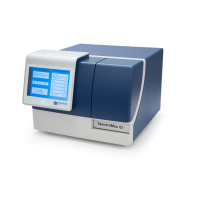Chapter 5: Read Modes and Read Types
5054747 B 101
Sample Volumes and Concentration of Reactants
The concentration of the luminescent agent impacts the quantity of light output in a
luminescent reaction. Light is emitted as a result of a reaction between two or more
compounds. Therefore, the quantity of light output is proportional to the quantity of the
limiting reagent in the sample.
For example, in an ATP/luciferin-luciferase system, when total volume is held constant and
ATP is the limiting reagent, the blanked light output is proportional to the concentration of
ATP in the sample, at very high concentrations of ATP. Substrate can be used up and become
rate-limiting, providing it is the rate-limiting component. In this case, the non-linearity is an
effect of the assay and not caused by the microplate reader.
Data Optimization
The measurement noise is dependent on the read time per sample (time per plate or time
per well). In particular, the detection limit improves when the read time is increased.
Therefore, it is important to specify the read time when comparing measurements.
All low-light-level detection devices have some measurement noise in common. To average
out the measurement noise, optimization of the time per well involves accumulating as
many counts as possible. Within some range, you can reduce noise (CVs, detection limit) by
increasing the read time per well, as far as is acceptable from throughput and sample
stability considerations.
Z´ is the standard statistical parameter in the high-throughput screening community for
measuring the quality of a screening assay independent of test compounds. It is used as a
measure of the signal separation between the positive controls and the negative controls in
an assay.
The value of Z´ can be determined using the following formula:
Z´ = 1 –
| Mean
c+
– Mean
c–
|
3
(SD
c+
) + 3(SD
c–
)
where SD is the standard deviation, c+ is the positive control, and c– is the negative control.
A Z´ value greater than or equal to 0.4 is the generally acceptable minimum for an assay.
Higher values might be desired when results are more critical.
Z´ is not linear and can be made unrealistically small by outliers that skew the standard
deviations in either population. To improve the Z´ value, you can increase the quantity of
label in the sample, if acceptable for the assay, or increase the read time per well.

